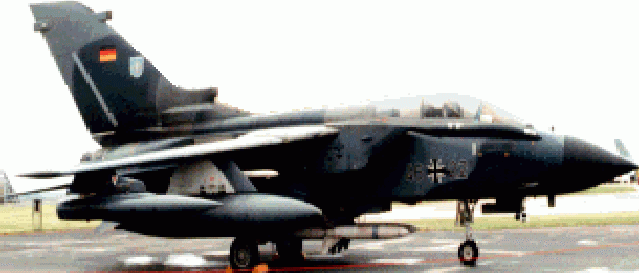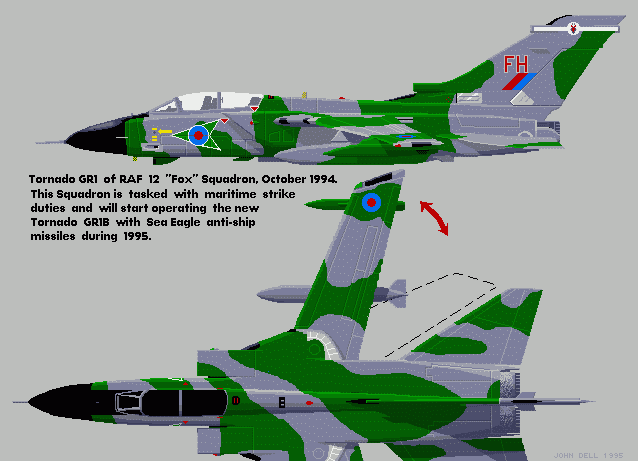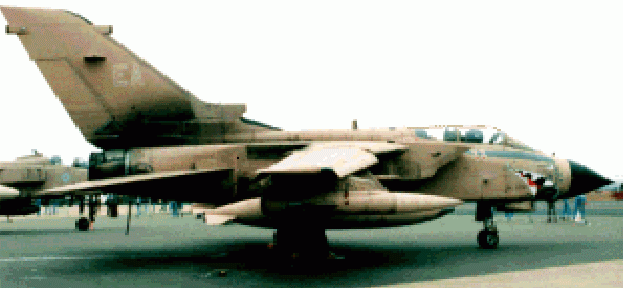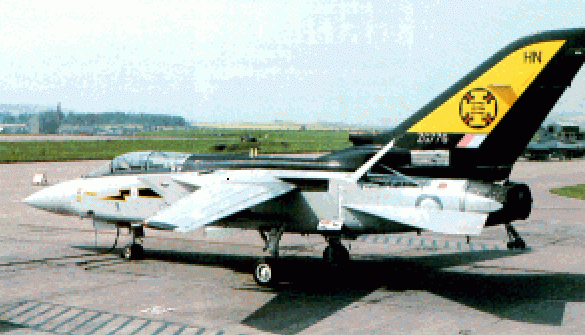Dinger's Aviation Pages
NOTE THIS PAGE IS AN ARCHIVE - THE INFORMATION ON IT HAS NOT BEEN UPDATED SINCE 1995
PANAVIA TORNADO
Back in 1995 I issued a DOS program on floppy disk called "RAF FASTJETS" which was written using IBM's "LINKWAY" product. All the information on this page is taken from that program, none of the data has been updated since 1995. The photos are from the collection of John Edwards.


There can be few aircraft more controversial than the Tornado. Is it the finest bomber and interdictor in the west's armoury, or is it a Jack-of-all-trades and master of none? Was it the only aircraft that could have taken out the runways of the Iraqi Air Force, or has the low-level strike mission for which it was designed been rendered obsolete?
In 1964 Britain had prototypes flying of a world-beating bomber, the TSR2. With long-range, high performance at both low and high altitude, and an internal bomb-bay, it would still be one of the best strike platforms in the world today if it had not been cancelled by Dennis Healey in a move that all but ended Britain's indigenous combat aircraft industry.

After flirting with the F-111 and an Anglo-French project, while also having to buy Phantom fighters as stop-gap bombers for the RAF, it was decided to design a Multi-Role Combat Aircraft (MRCA) for Britain, Germany and Italy. Panavia was formed to design and build the new aircraft. The conflicting requirements could not be met in a single airframe, so two versions emerged.
Firstly for Germany, Italy, and the RAF's strike force was the Interdictor-Strike version (IDS). This was optimised for low-level penetration of enemy airspace to bomb airfields, bridges and industry. The same aircraft could perform close support missions over the battlefield, again at low level. The Germans also needed the aircraft to be able to attack naval targets in the Baltic with anti-ship missiles.

Secondly, the British needed an aircraft to take over from its elderly Lightnings and Phantoms. So an Air Defence Version (ADV) needed to be designed to carry air-to-air missiles.
At the time variable-geometry (swing-wings) was in fashion. The Arab-Israeli 6-day war of 1967 had begun with the destruction of the Arab air force's runways. Swing-wing was seen as the way to keep high-performance jets operational from short lengths of improvised or repaired runway.
So MRCA emerged as a two-seat swing-wing aircraft. It carries all its stores on seven external pylons and is powered by two small but powerful RB199 engines. It gives its crew a very smooth ride at low level (Its nickname is the "lead sled"). The IDS version has both a ground mapping and terrain-following radar in the nose. The latter allows missions to be flown in bad weather and at night, an important step forward in NATO's defence capability at the time. On top of the high tail sit forward and rearward facing radar warning sensors to let the crew know if enemy radar is searching for them and also to warn them if a hostile radar "locks on". Like many modern aircraft, the wing itself has no control surfaces, only lift devices, flaps and slats. All control is via the fin rudder and all-moving tailerons.

The first prototype IDS Tornado was flown on 14th August 1974 and the first production deliveries of training aircraft were in 1980. Combat Squadrons had to wait until 1982-83 to start to equip with the new aircraft.
In RAF service the IDS version is known as the GR1. The GR1A reconnaissance version became available just in time to help track down Iraqi Scud missile launchers during the Gulf War. The GR1B is a new dedicated maritime strike version that will take over from the Buccaneer the role of attacking ships with the Sea Eagle missile. The Luftwaffe operate their own reconnaissance version of the Tornado.


The ADV version carries a Foxhunter radar in a redesigned nose. This can detect aircraft at over 115 miles range. The aircraft is lengthened to allow the fitting of four Skyflash missiles beneath the fuselage. The ADV has only a single, rear-facing, radar detecting pod on top of the tail. The ADV has a neat retracting in-flight refuelling probe, whereas the IDS versions were manufactured without such a probe and need an ugly bulge on the starboard side to accommodate one added later. The first ADV took to the air on 27th November 1979. The first batch, called the F Mk2, had the same Mk101 engines as the IDS version and control of the wing-sweep was manual, again like the IDS. The F Mk 3 has more powerful Mk104 engines and wing sweep control is automatic, along with other avionics improvements. The F Mk 2s were upgraded to Mk 3 standard except for the engines. In this form, they are known as F Mk 2A. The first F Mk3s were delivered to the RAF in July 1986. All of the FMk2s have been put into storage.

In 1994 Italy announced it was to lease 24 F-3s to bridge the gap until the introduction of Eurofighter.

The Tornado IDS is remarkably good at the mission it was designed for; low-level penetration of hostile airspace. With engines little more than half as powerful as those used in the F-111 and Sukhoi Su-24 its performance stands up well against them. However, times change and new methods of air warfare came to the fore during the Gulf War. Stealth technology, jamming, threat-suppression and high altitude laser designated strikes are seen as the way to hit the enemy and come home safe. The Tornado's poor high altitude performance with a full bombload means it is not well suited to these new methods. However many would argue that the Tornado's ability to go in fast and low would be invaluable in any future conflict where, unlike Iraq in the Gulf war, the enemy retained even partial command of the air with their own fighter force. The GR1 Tornado fleet is due for a major avionics and weapons system update between 1996 and 2000. Aircraft updated will be designated GR4.

The ADV is a platform for the Foxhunter/Sky Flash weapons system. It can stay on station for long periods as part of the larger system of AEW and ground-based radars, as such it is ideal for the defence of the UK against lower speed bombers. If it is removed from that environment and pitted against other fighter aircraft such as the Eagle, Mig 29 or Sokhoi 27 its chances of survival are much reduced.

Dimensions
Wingspan: 45ft 7.5ins (13.91 m)wings spread. 28ft 2.5ins (8.59 m) wings swept.
Wing area: 286.3 sq ft (26.6 m² )
Length:
IDS VERSION 54ft 10.5ins (16.72 m)
ADV VERSION 59ft 4 ins (18.08 m)
Armament
IDS:
2 internal 27mm Mauser cannons with 180 rounds each.
There are three under-fuselage pylons and 4 rotating underwing pylons allowing up to 19,840 lb of stores to be carried.
In Operation Desert Storm a typical load for an RAF Tornado bomber would have been two large fuel tanks, two AIM-9 short range air-to-air missiles for defence, two jamming pods and eight 1,000 lb (454 Kg) bombs.
Weapons carried by IDS Tornados include normal "iron" bombs, laser guided bombs (LGBs), JP233 runway denial pods (RAF), MW-1 runway denial pods (Luftwaffe) Alarm anti-radar missiles (RAF) , Sea Eagle anti-ship missiles (RAF) , Kormoran anti-ship missiles (Luftwaffe), BL755 Cluster bombs, WE 177 nuclear bombs (RAF).
ADV:
Air defence Tornados have a single 27mm Mauser cannon on the starboard side of the nose. They can carry up to four AIM-9 Sidewinder missiles mounted
alongside the fuel-tank pylons and four semi-recessed Skyflash missiles under the fuselage.
ENGINES
IDS and F2:
Two Turbo-Union RB199-34RMk101 turbofans giving 8,500 Ib of static thrust (16,000 Ib with afterburners). They have thrust reversers to reduce the length of landing runs. These engines have a very low fuel consumption giving the Tornado increased range. The RB199 Mk101 is only 34 inches (86.5 cm) in diameter and 126 inches long (3.2m).
F3:
The Royal Air Force and Royal Saudi Air Forces F MK3 ADV Tornados have the Mark 104 of the RB199-34R engine. This gives increased thrust: 9,100 lb static thrust or 16,500 Ib with afterburner. The Mk104 engine can be distinguished by its longer tailpipe which extends beyond the base of the tailfin on the F Mk 3. The earlier F Mk 2 ADV version retained the Mk 101 engine.
PERFORMANCE
Max speed: 920mph (1,480 km/h) at low level (Mach 1.2).
1,450mph (2,333 km/h) at 40,000 feet (12,190m) (Mach 2.2)
Range: The IDS version has a combat radius of about 850 miles (1,368 km) depending on bombload and mission profile.
The ADV can stay on combat air patrol (CAP) for two hours at 400 miles (644 km) from its base.
The ferry range is about 2,500 miles (about 4,000 km).
The Tornado can climb to 30,000 ft (9,145 m) in less than two minutes.
THE ABOVE ARTICLE HAS BEEN "FROZEN" AS IT WAS WRITTEN IN 1995.
UPDATED INFO:
Tornado IDS aircraft were updated to GR4 or 4A standard. This enabled them to carry Brimstone anti-armour and Storm Shadow stand-off missiles.
The ADV F3 Version was replaced in RAF service by the Eurofighter Typhoon. The F3 left RAF service in 2011.
The Italians operated the F3 version from 1995 until 2004, leased from the UK.
Saudi Arabia purchased both the IDS and F3 ADV versions of the Tornado. The F3 ADV version was retired by 2011, but the IDS continues in service (2025).
A British planned long-term replacement for Tornado IDS, British Aerospace's Future Offensive Aircraft Project (FOA) which was to use stealth technology was cancelled. This was then replaced by a "talking shop" of different parties called the "Future Offensive Air System" (FOAS) to investigate potential ways of replacing the Tornado. The FOAS was then itself wound-down.
Commitments in Syria delayed the withdrawl of the IDS Tornado from RAF service. It ended service in 2019, its strike role being taken over by the Typhoon. It continues in service with the German Luftwaffe and Italian Aeronautica Militare but the conflict in Ukraine is likely to speed up replacement by the American F-35 and the latest versions of the Eurofighter Typhoon.
